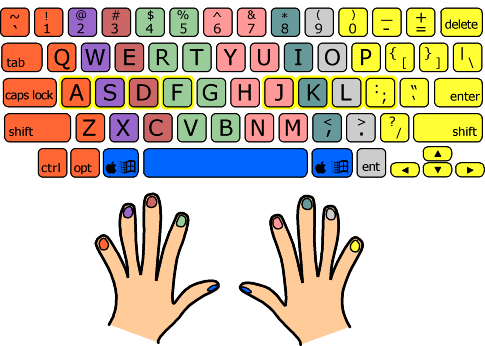1 Точність
Я намагався покращити свою швидкість протягом місяців, і я не бачив великого покращення. Як тільки я сповільнився і почав бути точнішим, замість того щоб намагатися набирати швидше, я почав помічати зростання швидкості набору тексту. Я відчуваю більшу контрольованість також. У мене ще є шлях до свого особистого цільового результату, але я раджу бачити, що я зараз покращуюся і більше розслаблююся.
Спочатку вчіться бути точними, а потім покращуйте швидкість. Тому що, якщо ви робите помилки постійно, то чим довше ви будете набирати, тим довше це займе. Кожен раз, коли ви видаляєте назад, це займає більше часу, ніж якщо ви трошки сповільнитесь, щоб ви могли набирати точно. Я все ще роблю багато помилок, але я розумію, що, коли я сповільнююсь, щоб бути точним, я фактично схильний набирати трошки швидше.
2 Практика
Для новачків: Практикуйте. Звикайте до дому, працюйте до того моменту, коли вам не потрібно буде дивитися або на те, що ви вводите, або на ваші пальці на клавіатурі.
Для досвідчених швидкотиків: Практикуйте. Розвивайте м'язову пам'ять для набору певних типів часто вживаних буквених пар. Визначте комбінації букв для певних слів, які вам утруднюють завдання, і практикуйте набір їх в окремості до того моменту, коли вам більше не потрібно буде думати, роблячи це.
Мій порада щодо покращення швидкості набору - це не тільки часта практика, але й правильна практика. Спробуйте позбутися поганих звичок в наборі тексту і замінити їх хорошими. Наприклад, ви повинні використовувати кожен палець при наборі тексту, а не полагоджуватися на використання пальців, з якими вам найзручніше. Повне використання обох рук необхідне для досягнення максимального потенціалу в наборі тексту.
3 Розтягування
Коли мої зап'ястя стають неживими від набору тексту, я захоплюю свої пальці однією рукою і витягую руку на повну довжину, повільно витягуючи пальці назад. Потім я розтягую свої пальці, відкриваючи і закриваючи їх, нахиляю руки взад і вперед, і обертаю зап'ястя.
Якщо ви відчуваєте трошки біль на пальцях або суглобах, просто підніміть руки вгору і вируште пальцями (робіть це тільки в разі болючого відчуття на пальцях). і якщо вас болять суглоби, просто зробіть ліву руку кулаком і зробіть те саме правою. Дном вашого лівого кулака постукаєте по суглобах правої руки і навпаки.
4 Знайомтеся з вашою клавіатурою
Мій порада для покращення швидкості набору - відчувайте букви "F" і "J". Як більшість знає, це букви, які ви спочатку відчуваєте на клавіатурі. З часом, навчившись набирати без допомоги огляду, вам навіть не потрібно буде відчувати "F" і "J", ви просто вивчити клавіатуру.
Також важливо ознайомитися з клавіатурою, якою ви користуєтеся. - Це необхідно, оскільки, якщо ви можете уявити карту клавіатури у своїй уяві, вам не потрібно відводити погляд від екрана, щоб знайти потрібну вам клавішу. Це також зменшить час між тим, як ви переносите свої багато думок на екран перед тим, як втратити їх (знову).
Якщо ви набираєте 60 слів за хвилину чи більше, і хочете покращити свою навичку, не отримуючи карпальний канал: купіть механічну клавіатуру. Я використовую червоний перемикач, який я купив як для гри, так і для набору, і після години набору мої пальці все ще відчувають себе добре. Я не рекомендував би червоний для більшості набиральників - в нього немає зворотного зв'язку, як у інших типах перемикачів, і деякий час потрібно, щоб звикнути до того, щоб не постійно натискати клавіші до кінця.
5 Ритм
Важливо розвивати ритм, не поспішаючи, але бути точним, з високим пріоритетом. Швидкість приходить природно з практикою та часом. Крім того, треба прагнути до саморозвитку, але при цьому визнавати, що ефективність визначається лише разом із ефективністю. Загалом, треба вчитися набирати тільки те, що ви бачите/читаєте; ніколи не змінюйте слова, якщо, звісно, це не редагування ... вправа/тест. Ви набираєте лише те, що бачите або читаєте!
Почати тренування
Сліпий набір тексту
Техніка сліпого друку - це набір тексту
без перегляду на клавіатуру. Ідея полягає в тому, щоб навчити пальці розташуванню кожної клавіші. Клавіші
F і J мають підняту смужкуабо крапку, що дозволяє пальцю їх ідентифікувати. Як тільки ви розмістили свої два вказівника на цих клавішах, інші пальці розташовуються на клавішах поруч.
Щоб набирати швидко, вам потрібно бути обережними, яким пальцем ви натискатимете клавішу. Подивіться на малюнок нижче.
Кожен колір відповідає певному пальцю. Наприклад, лівий вказівник має світло-зелений колір і повинен натискати лише світло-зелені клавіші.

Деякі клавіші є особливими.
ASDF і JKL; - це базові позиції для ваших пальців. Ваші пальці переходять з базової позиції на клавішу, яку ви хочете натискати.
Дуже корисною річчю при вивченні техніки сліпого друку є
запам'ятовування клавіатури і створення уявного ментального мапу пальців.Ви повинні бути в змозі натискати будь-яку клавішу навіть без думок.Наприклад, якщо я кажу C, вам треба подумати про те, щоб опустити середній палець вниз і натиснути C миттєво. Це можна досягти лише практикою. Вам потрібно нарощувати м'язову пам'ять кожного пальця.
Основні ідеї
* Розмістіть вказівники на F і J
* Кожну клавішу повинен натискати той самий палець завжди
* Не дивіться на клавіатуру, ваші очі завжди повинні дивитися на екран
* Вправляйтеся!
Пройти тестування набору тексту
